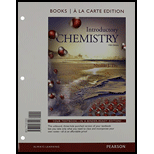
Interpretation:
Each
Concept Introduction: Oxidation is defined as the loss of electrons.
Reduction is defined as the gain of electrons.
When oxidation and reduction simultaneously take place, then it is known as redox reaction.
In balanced redox reaction, each of the atom on both sides of reactions is equal.
To
Assign the oxidation states to all the atoms. Identify the substances that are being oxidized and reduced.
Separate the reaction into two half-reactions: oxidation half reaction and reduction half reaction.
Balance each of the half-reaction with respect to mass in the following order:
Balance all the elements other than
Balance
Balance
Balance the charges
Balance each of the half-reaction with respect to charge by adding the electrons to the right side of the oxidation half-reaction and the left side of the reduction half-reaction.
Multiply one or both half-reactions (if required) by a small whole-number so as to make sure the number of electrons in both half-reactions by a small whole number.
Add the two half reactions by cancelling electrons and other species (if required) to obtain a balanced chemical reaction.
Verify that the reaction is balanced with respect to both mass and charge.
Want to see the full answer?
Check out a sample textbook solution
Chapter 16 Solutions
Introductory Chemistry, Books a la Carte Edition & Modified MasteringChemistry with Pearson eText -- ValuePack Access Card -- for Introductory Chemistry Package
- Describe what you expect to happen when the following solutions are electrolyzed: a aqueous Na2SO4; b aqueous KBr. That is, what are the electrode reactions? What is the overall reaction?arrow_forwardFor the reaction Cu2+(aq) + Zn(s) → Cu(s) + Zn2+ (aq), why can’t you generate electric current by placing a piece of copper metal and a piece of zinc metal in a solution containing CuCl2(aq) and ZnCl2(aq)?arrow_forwardConsider the following cell running under standard conditions: Fe(s)Fe2+(aq)Al3+(aq)Al(s) a Is this a voltaic cell? b Which species is being reduced during the chemical reaction? c Which species is the oxidizing agent? d What happens to the concentration of Fe3+(aq) as the reaction proceeds? e How does the mass of Al(s) change as the reaction proceeds?arrow_forward
- Consider these half-reactions: (a) Which is the weakest oxidizing agent? (b) Which is the strongest oxidizing agent? (c) Which is the strongest reducing agent? (d) Which is the weakest reducing agent? (e) Will Sn(s) reduce Ag+(aq) to Ag(s)? (f) Will Hg() reduce Sn2+(aq) to Sn(s)? (g) Name the ions that can be reduced by Sn(s). (h) Which metals can be oxidized by Ag+(aq)?arrow_forwardAn electrolytic cell is set up with Cd(s) in Cd(NO3)2(aq) and Zn(s) in Zn(NO3)2(aq). Initially both electrodesweigh 5.00 g. After running the cell for several hours theelectrode in the left compartment weighs 4.75 g. (a) Which electrode is in the left compartment? (b) Does the mass of the electrode in the right compartmentincrease, decrease, or stay the same? If the masschanges, what is the new mass? (c) Does the volume of the electrode in the right compartment increase, decrease, or stay the same? If the volumechanges, what is the new volume? (The density of Cd is8.65 g/cm3.)arrow_forward(a) Rank the following metals in their ability to function as reducing agents: Hg, Sn, and Pb. (b) Which halogens will oxidize mercury to mercury(II)?arrow_forward
- Consider the following galvanic cell: Calculate the concentrations of Ag+(aq) and Ni2+(aq) once the cell is dead.arrow_forwardFor the following half-reactions, answer these questions. Ce4+(aq)+eCe3+(aq)E=+1.61VAg+(aq)+eAg(s)E=+0.80VHg22+(aq)+2e2Hg(l)E=+0.80VSn2+(aq)+2eSn(s)E=0.14VNi2+(aq)+2eNi(s)E=0.24VAl3+(aq)+3eAl(s)E=1.68V (a) Which is the weakest oxidizing agent? (b) Which is the strongest oxidizing agent? (c) Which is the strongest reducing agent? (d) Which is the weakest reducing agent? (e) Will Sn(s) reduce Ag+(aq) to Ag(s)? (f) Will Hg(l) reduce Sn2+(aq) to Sn(s)? (g) Which ion(s) can be reduced by Sn(s)? (h) Which metal(s) can be oxidized by Ag+(aq)?arrow_forwardAssign an oxidation number to the underlined atom in each ion or molecule. (a) Fe2O3, (b) H2SO4, (C) CO32- (C) NO2+arrow_forward
 Chemistry: Principles and PracticeChemistryISBN:9780534420123Author:Daniel L. Reger, Scott R. Goode, David W. Ball, Edward MercerPublisher:Cengage Learning
Chemistry: Principles and PracticeChemistryISBN:9780534420123Author:Daniel L. Reger, Scott R. Goode, David W. Ball, Edward MercerPublisher:Cengage Learning Chemistry & Chemical ReactivityChemistryISBN:9781133949640Author:John C. Kotz, Paul M. Treichel, John Townsend, David TreichelPublisher:Cengage Learning
Chemistry & Chemical ReactivityChemistryISBN:9781133949640Author:John C. Kotz, Paul M. Treichel, John Townsend, David TreichelPublisher:Cengage Learning Chemistry & Chemical ReactivityChemistryISBN:9781337399074Author:John C. Kotz, Paul M. Treichel, John Townsend, David TreichelPublisher:Cengage Learning
Chemistry & Chemical ReactivityChemistryISBN:9781337399074Author:John C. Kotz, Paul M. Treichel, John Townsend, David TreichelPublisher:Cengage Learning Chemistry: The Molecular ScienceChemistryISBN:9781285199047Author:John W. Moore, Conrad L. StanitskiPublisher:Cengage Learning
Chemistry: The Molecular ScienceChemistryISBN:9781285199047Author:John W. Moore, Conrad L. StanitskiPublisher:Cengage Learning General Chemistry - Standalone book (MindTap Cour...ChemistryISBN:9781305580343Author:Steven D. Gammon, Ebbing, Darrell Ebbing, Steven D., Darrell; Gammon, Darrell Ebbing; Steven D. Gammon, Darrell D.; Gammon, Ebbing; Steven D. Gammon; DarrellPublisher:Cengage Learning
General Chemistry - Standalone book (MindTap Cour...ChemistryISBN:9781305580343Author:Steven D. Gammon, Ebbing, Darrell Ebbing, Steven D., Darrell; Gammon, Darrell Ebbing; Steven D. Gammon, Darrell D.; Gammon, Ebbing; Steven D. Gammon; DarrellPublisher:Cengage Learning





